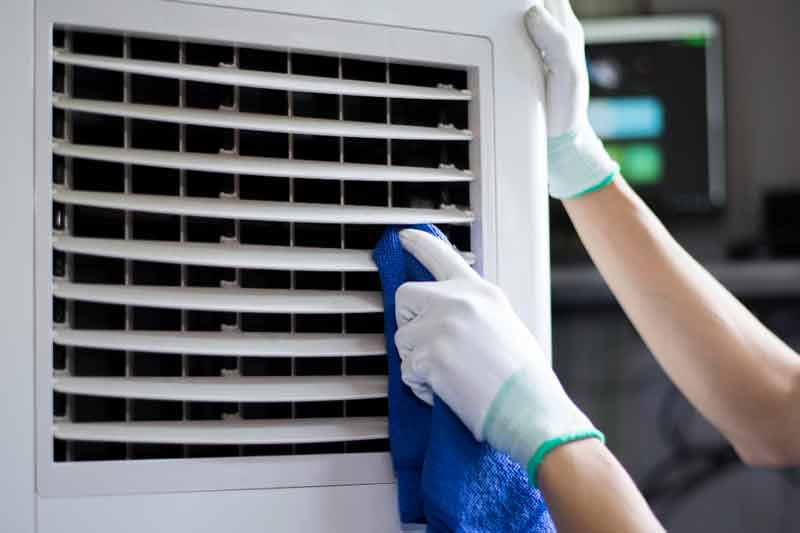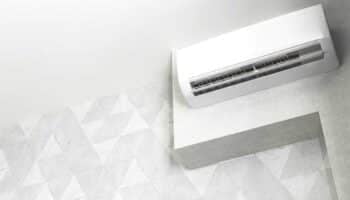So you’ve bought a new AC. Congratulations!
Or maybe you’ve had yours for a while.
Do you know how to take care of it? No worries. The following is a list of all the best practices portable air conditioner owners need to know. From the initial installation to cleaning and maintenance, we’ll give you all the info you need to keep your AC in prime working condition.
Ready? Let’s go.
Installation and Setup

If you’ve already tackled this section and have your portable air conditioner up and running, you can move on to the next section. However, it might be a good idea to read through and make sure your current setup is optimal.
There’s no sense in paying more to run your AC when a few simple changes could save you a few dollars, right?
#1 Window Kit Installation
Most portable air conditioners come with a window kit, so be sure to follow the manufacturer’s guidelines.
Windows that slide up and down will require you to put the kit at the bottom, while Windows that slide horizontally will require you to put the kit to one side. In the first case, you’ll extend the kit upwards, and in the second you will extend it sideways.
Since there’s a good chance that the kit is not the perfect size for your window, you may need to trim the adapter. Depending on the material the adapter was made with, you may be able to use a box or utility knife, but you may need something stronger, like a circular saw.
If your window is too big instead of too small, you’ll need to find something to fill the gap with. Some alternatives are:
- Cardboard
- Plexiglass
- Plywood
- Foam board
Of course, you also have the alternative of choosing a different window entirely.
Once the kit butts up against either the window frame or plexiglass etc., fix it in place. Depending on the kit, you might need to tighten the included self-tapping screws or press-in bolt to secure the adapter to the window.
Additionally, some kits come with a security bracket. If so, make sure it’s securely fastened to the frame, since this will prevent someone from opening the window sash from the outside.
#2 Additional Ventilation Options
In some homes, it may not be feasible to vent your air conditioner out a window. In that case, there are some other options.
Sliding glass door. You can buy a kit specifically for a sliding door, but you may also be able to modify the included kit to be installed vertically in your sliding door.
Chimney. Only consider this option if you have a chimney that’s no longer in use. The vent hose can be attached to the inside walls of the chimney.
An exterior wall. Bashing a hole through a wall may seem extreme, but if you don’t have a window or sliding door, it is an option. And it doesn’t have to be ugly!
However you end up venting your air conditioner, one very important consideration is to keep the exhaust hose as straight as possible.
#3 Electrical Requirements
Confirm that the outlet you plan to use is on a circuit that will match the electrical requirements of your air conditioner. Bigger air conditioners with higher wattage may require a dedicated outlet.
Using an extension cord is typically not advised by manufacturers, however, if you must use one be sure to use an extension cord of the appropriate gauge and length for your specific unit.
Operating and Maintenance Tips

If you maintain a regular schedule of maintenance, your air conditioner will work better and last longer. Additionally, the optimal settings may save you money.
#1 Temperature Setting
Ultimately, you can set the desired temperature at whatever you want, but there are a few things to keep in mind.
Assuming you care about how much it costs to run your air conditioner, there are a few different recommendations. Energy Star recommends setting your thermostat to 78°F (25°C) or higher but others recommend the setting of 75°F.
If you set your temperature too low there is a chance that your condenser can freeze over, which may make your air conditioner inoperable for a while—at least.
#2 Fan Setting
Avoid putting the fan in the on position whenever you can, instead, use the auto setting.
Auto means the fan will turn on and off as necessary but when it’s in the on position, it will run until you manually turn it on. Running the fan constantly can increase the humidity in your home, which is exactly the opposite of what your air conditioner is trying to do.
#3 Air Filter Maintenance
Many portable air conditioners have permanent filters — these only need to be cleaned they don’t need to be replaced. However, some do have filters that need to be replaced.
Your owner’s manual will recommend a schedule for cleaning or replacement of your air filter. Having said that, there is a general recommendation that air filters should be cleaned about once a week for optimum efficiency.
Your air conditioner may have more than one filter, and there’s no guarantee that both will need the same treatment. Again, refer to your user’s manual.
#4 Condensate Removal
All air-conditioners, whether central, window, or portable, produce condensate that needs to be drained or evaporated.
Even if you have a portable air conditioner that has a self-evaporation system, in highly humid areas, you will still need to drain some condensate.
Additionally, some air-conditioners will have a built-in condensate pump that assists in draining directly to a floor drain.
Check your owner’s manual for the proper drainage process, and determine whether or not your unit has a single or multiple condensate reservoirs.
#5 Regular Cleaning
A dirty portable air conditioner can lead to all sorts of problems. Before you know it, they could be making terrible noises or smelling like something burning.
Ideally, you should clean your air conditioner twice during the cooling season. If you’re following a good cleaning and maintenance schedule, you’re already cleaning your filters on a regular basis, but there are a few other things you want to do as well.
Clean your water reservoir. Even if you’re regularly draining condensate, mold or algee can grow in the tank. At least every few weeks, wipe the interior down with a vinegar and water solution.
Keep the exterior vents clean. In order for air to move freely, regularly dust and/or clean the exterior vents. A soft cloth and some warm water and dish soap are sufficient.
Check for dirty coils. Your air conditioner has two coils, an evaporator coil, and a condenser coil. It’s important that both of these be kept clean since a buildup of dust and dirt can impact the performance of your air conditioner. In some cases, it might even stop your air conditioner from working.
First, clean the coils by removing any excess or loose dust and debris with a soft brush or cloth. Once that’s swept away, you can use a mixture of warm water and dish soap or purchase a can of coil cleaner from your local big box or hardware store.
Storage and Winterizing
At the end of the season, it’s important to store your portable air conditioning unit properly. For one thing, that means storing it when it’s clean. If you’re following the guidelines of thoroughly cleaning your unit twice per season, it’s a good idea to schedule the second cleaning when it’s time to put it away for storage.
Regardless, make sure you do the following before storing it for the winter.
#1 Drain the Condensate Reservoir
Whether you have single or multiple condensate reservoirs, be sure they’re empty. And then take it a step further by making sure the containers are also dry.
You don’t want to store your air conditioner away if it has any moisture anywhere. You can wipe everything down with a cloth or run the AC in fan mode only for about 30 minutes.
#2 Clean or Replace Air Filters
If you have air filters that need to be replaced, remove the dirty ones and either reinstall a clean one now or wait until the beginning of the new cooling season. If you have a permanent filter that needs to be washed, make sure it’s clean and fully dry before storing the unit.
#3 Disconnect the Window Kit
Remove the hose from the window and make sure that it’s completely dry inside—just let it sit somewhere in a straight line, and it will air dry.
Remove all parts from the window so that it properly seals closed again. Failure to create a proper seal in the window during the colder months means you’re letting the heat you’re paying for out and the cold you don’t want in.
#4 Storage
Make sure to store everything for the season someplace dry — to avoid mold growth — and that the hose doesn’t have any sharp angles. If possible, put everything back in the original packaging.
Conclusion
Okay, that may seem like a lot you need to do to care for and maintain your portable air conditioner — but it really isn’t. Mainly because a lot of it is repetitious, with the most important and often recommended being to keep your AC clean.
To recap, here are the best practices we covered, broken down into sensible sections.
Installation and Setup
- Window kit installation
- Additional ventilation options
- Electrical requirements
Operating and Maintenance Tips
- Temperature setting
- Fan setting
- Air filter maintenance
- Condensate removal
- Regular cleaning
Storage and Winterizing
- Drain the condensate reservoir
- Clean or replace air filters
- Disconnect the window kit
- Storage
Follow those steps every season and you’ll have your portable air conditioner working in optimal performance for its lifespan.
Hopefully, this information has helped you! While you’re here, why not check out some of our related posts below? Perhaps we can help you with something else.







